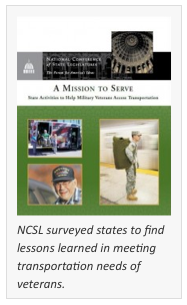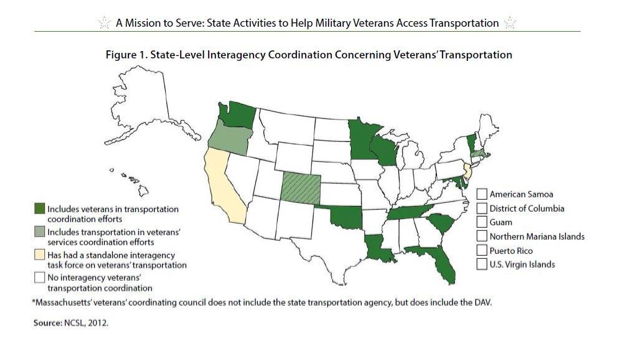This action to improve veterans transportation seems like a no brainer, but few states are doing it. According to this chart – from early in 2013 and so admittedly now outdated – few states actually include veterans in their transportation coordination efforts. Doesn’t this seem odd? Still, many transportation providers work with veterans and their organizations, so maybe it’s better than it seems from this map.
It seems to us that one way veterans transportation services could be improved is to include veterans in the discussions and meetings.
Why is this important?
 A disproportionate number of veterans live in rural areas, where community services and transportation are less available. Veterans also are more at risk than the general population for unemployment, homelessness, post-traumatic stress disorder, major depression and suicide. Reliable, affordable and accessible transportation choices are critical for the many veterans who need to access to medical care, social services, and jobs among other things.
A disproportionate number of veterans live in rural areas, where community services and transportation are less available. Veterans also are more at risk than the general population for unemployment, homelessness, post-traumatic stress disorder, major depression and suicide. Reliable, affordable and accessible transportation choices are critical for the many veterans who need to access to medical care, social services, and jobs among other things.
Many states are now working to ensure that every veteran—regardless of his or her geographical location, physical ability, financial constraints or other circumstances—has a dignified and dedicated means of transportation for everyday and special travel.
An October 2 webinar will highlight ways in which states support veterans’ transportation, including interagency coordination; funding; veterans’ transportation programs; leadership; exemptions from fees, taxes, fares and tolls and more. The webinar builds off a January 2013 report (pdf) from the National Conference of State Legislatures (NCSL).
…
Larry Ehl is the founder and publisher of Transportation Issues Daily. In the public sector, Larry was Federal Relations Manager for Washington State DOT; Chief of Staff to US Senator Slade Gorton; and was twice elected to the Edmonds School Board.







 RSS Feed
RSS Feed